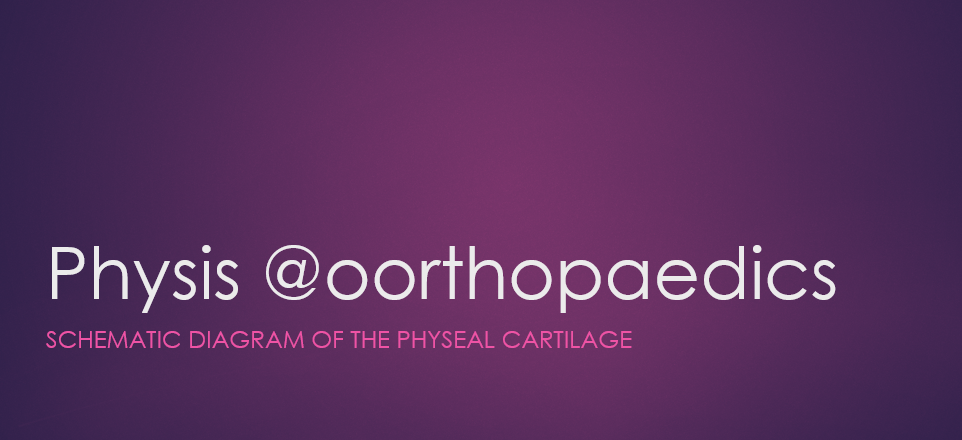Infectious non-union is a condition in which fracture fails to unite due to some infectious process locally or systemically. There are several classification systems for this type of non-union. Here we discuss four of them. 4 Classifications Systems of infectious non-union May’s classification Weiland Kulkarni Umiarov May’s classification It’s essentially the extension of classification of… Continue reading 4 classifications of infectious non-union
Category: Basic Sciences
2 schematic diagrams of physis
Here we present two schematic diagrams of the physis. The physis is the horizontal growth plate present in pediatric bones. It is from the physis, longitudinal growth takes place. Source: AAOS Orthopaedic Review
5 Differences between Ponseti and Kite’s Techique
Ponseti and Kite’s Techique are two different types of maneuvers for manipulating the deformities in CTEV. Ponseti Technique is a brainchild of the lifetime of work by Dr. Ignacio Ponseti. On the other hand, Kite’s technique is by Dr. JH Kite. 5 differences between Ponseti and Kite’s technique. Ponseti Technique In a child with CTEV,… Continue reading 5 Differences between Ponseti and Kite’s Techique
4 Principles of Pelvic Damage control
Pelvic damage control is an approach for stabilizing pelvic injuries, in order to improve the overall physiology of a patient. Since, pelvic fractures cause maximum of blood loss in a patient, it is necessary to prevent complications in a primary setting. Here, we outline the four different principles of pelvic damage control Close reduction of… Continue reading 4 Principles of Pelvic Damage control
3 MCQs on biomechanics of orthopaedic screws
Biomechanics of orthopaedic screws, are often confusing. They are simple but the way question is set, confuses a lot of us. Here we present these multiple choice questions (MCQs) Question 1 For a maximum pull out strength, a screw should have a. Maximum outer diameter, small root diameterb. Small outer and large root diametersc. Large… Continue reading 3 MCQs on biomechanics of orthopaedic screws
4 different types of rickets to know in orthopaedics
Types of rickets are important to know and understand. To define, rickets is bony manifestation of altered vitamin D, calcium and phosphorous metabolism in a child leading to inadequate mineralization of bone. Four different types of rickets on the basis of etiology are Nutritional Hereditary vitamin D deficiency Familial Hypophosphatemic rickets, and Hypophosphatasia Nutritional rickets… Continue reading 4 different types of rickets to know in orthopaedics
10 Diseases and factors that affect the growth plate
There are a lot of diseases and factors that affect the growth plate. Growth plate or physis is the region between the epiphysis and metaphysis of a growing bone. Injury to this physeal region may lead to several complications. Here, we enumerate these factors for your information Gaucher Diastrophic dysplasia Pseudoachondroplasia Kniest dysplasia Achondroplasia Gigantism… Continue reading 10 Diseases and factors that affect the growth plate
Ziehl-Neelsen (ZN) staining: 8 organisms and 10 steps
Ziehl-Neelsen (ZN) staining is a specific bacteriological stain used to identify acid fast organisms. 8 Organisms that stain with Ziehl-Neelsen Procedure Mycobacterium tuberculosis and M. leprae Mycobacterium avium intracellulare (atypical) Nocardia spp. Rhodococcus spp. Legionella micdadei Schistosoma spp. (cortical spines) Echinococcus spp. (hooklets) Protozoa – Cryptococcus spp. ZN staining is a simple staining process. It… Continue reading Ziehl-Neelsen (ZN) staining: 8 organisms and 10 steps
15 differences between vascular and neurogenic claudication
Differences between vascular and neurogenic claudication are a must know for exams. Claudication comes from latin word claudicare which means “limp”. Vascular claudication is the discomfort that comes from a vascular cause. On the other hand, neurogenic type is due to compression of nerve root or spinal cord. Here, we enumerate these 15 differences 1.… Continue reading 15 differences between vascular and neurogenic claudication
12 Differences between adult and pediatric bone
The pediatric bone differs very much in structural, biochemical, and functional aspects from the adult bone. These differences between adult and pediatric bone can be enlisted as 1. Physis: The pediatric bone consists of physis or the growth plate. The growth plate lies between the epiphysis and metaphysis in long bones. By virtue of this… Continue reading 12 Differences between adult and pediatric bone








